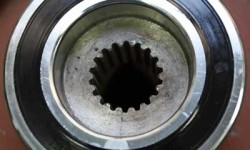
A bridge to the history
One of Spain’s most emblematic engineering achievements can be found in the Basque country. It’s the Puente Colgante (the Hanging Bridge), and it stands upstream from the port of Bilbao, straddling the river Nervión like a skeletal colossus.
One of Spain’s most emblematic engineering achievements can be found in the Basque country. It’s the Puente Colgante (the Hanging Bridge), and it stands upstream from the port of Bilbao, straddling the river Nervión like a skeletal colossus.
The official nameof Puente Colgante is the Biscay Bridge – one of a handful of surviving transporter bridges in the world still in operation. The bridge, in Spain’s Basque region, connects the busy middle-class suburb of Las Arenas with the charming old fishing town of Portugalete. It is an indispensable part of every- day life for thousands of people, carrying both cars and foot passengers in each direction. The Puente Colgante operates 24 hours a day, 365 days a year.
The principle of the bridge is simple: Two towers on either side of the river are connected by latticed steel crossbars, on which run two sets of tracks. A carriage, powered by 12 electric motors, rides on the tracks. Cables attached to the bottom of the carriage hold the gondola. The principle is similar to a ski lift. The towers are supported and braced by a series of massive steel cables that are embedded in concrete on either side of the river.
How did this bridge come into being? A gifted young Basque architect, Alberto de Palacio y Elissagüe, who had designed the Crystal Palace in Madrid, was asked in the late 1880s to develop a project that would connect both banks of the river Nervión at its mouth. The three fundamentals of the project were that it should not interrupt river traffic, it should be able to carry passengers, freight and livestock, and it should have reason-able construction costs. Having considered and rejected various bridge types – swing, lift, cantilever and fixed – Palacio decided that the best solution would be a bridge high enough to permit large ships to sail under it, with a moveable platform suspended from a system of moving cables. The principle was already known (an American engineer had published a design for a transporter bridge in 1869), but the Puente Colgante would be the first of its kind to actually be constructed.
Palacio had developed a friendship with Gustave Eiffel and was a great admirer of both the construction techniques and aesthetics used in building the Eiffel Tower.
He decided touse a similar system, collaborating with an equally brilliant young French engineer, Ferdinand Arnodin, who later went on to employ similar techniques in his work on Britain’s Newport Transporter Bridge. It was Arnodin who came up with the structural solution of bracing the whole structure with a system of massive steel cables embedded in concrete blocks on either side of the bridge. Construction started in 1890, and the bridge opened for business in 1893. Reflecting social conditions of the time, the passenger platform was equipped with sheltered seating for first-class passengers, while second-class passengers had to endure an open central section, which they shared with cattle, freight and carriages.
The bridge’s history is chequered. During the Spanish Civil War it sustained minor bomb damage, but in 1937 it was blown up by Republican forces. Its crossbar plummeted into the river, and the two towers suffered major damage. Ironically, this was five days before the war came to an end. Reconstruction did not start until 1939, but by mid-1941 the bridge was back in action, still run by the same private business, which continued to administer and maintain the Puente Colgante until 1996, when a new management company, El Transbordador de Vizcaya, took over.
With a bridge of this type in constant operation, safety and maintenance are top priorities. The management company employs a team of five people who exercise constant vigilance over the mechanical and structural state of the bridge. The team is headed by José Ramón, a tough, burly, no-nonsense Basque engineer who has worked on the bridge for 25 years. “The bridge is my life,” he proudly exclaims and goes on to talk about some of the challenges involved. Ramón points out that the bridge operates in highly aggressive and difficult conditions. “We have to deal with the effects of industrial pollution, as well as high winds, sharp changes in temperature, salt, rain and mist. That’s why the gondola has 18 security cables!”
The impact of hostile environmental conditions is most vividly seen on the components of the cable carriages that run on the crossbar tracks. Each motorized carriage has 36 wheels, and each wheel is equipped with two main bearings. Six of the wheels on each carriage are motorized.
“Our biggest problem has been the bearings on the motorized carriages,” comments Ramón. “And getting to them, of course. An acrobat wouldn’t last 10 minutes in this work.” Ramón and his team are used to bearings failures and are on constant standby to make emergency repairs. “We have enough power and flexibility to keep the gondola moving, even if some of the carriage bearings fail, and we are committed to keeping the bridge in operation no matter what,” he says. “We can’t have passengers stranded two metres above the surface of the river.”
But after one particularand major bearing failure in 2006, the company approached SKF, to ask for its help in developing a more robust and less environmentally vulnerable bearing. SKF responded with a solution based on bearings supplied to users in mountainous conditions such as ski stations – a bearing that uses a porous composite material impregnated with lubricant, which retains the lubricant even if the protective cover is broken.
So, with the watchwords being safety and reliability, Ramón and his team continue to keep the Puente Colgante running day and night. “We are part of living history,” Ramón states with justifiable pride. Such is the Puente Colgante’s fame that it is the first engineering achievement in Spain to be designated a UNESCO World Heritage Site.
Solid Oil solution
SKF has been supplying bearings for the motorized carriages of the Puente Colgante since 2002. Following an unexpected bridge stoppage due to a major bearing failure in 2006, SKF area account manager Jesús Carlos Arce Lastra was contacted by the local distributor, RADIAL. SKF engineers in Madrid had a materials solution readily available in the form of Solid Oil.
This form of lubrication had been developed for cases where access problems make relubrication virtually impossible and where very good contaminant exclusion is required. Drawing on solutions already devised for other users in hostile environments such as mountain resorts and ski stations, SKF was able to respond quickly, developing and manufacturing a custom-made bearing for the motorized carriages on the bridge, incorporating a semi-solid lubricant in the form of composite porous and oil-impregnated material.
This solution has proved highly effective against the impact of bad weather, corrosion, vibration and general stress. Even if the protective covers are damaged, the bearing retains its lubricant. And in the year since the bearings were fitted, the Puente Colgante has seen a significant increase in reliability of operation of the motorized carriages that support and move the passenger platform below.







